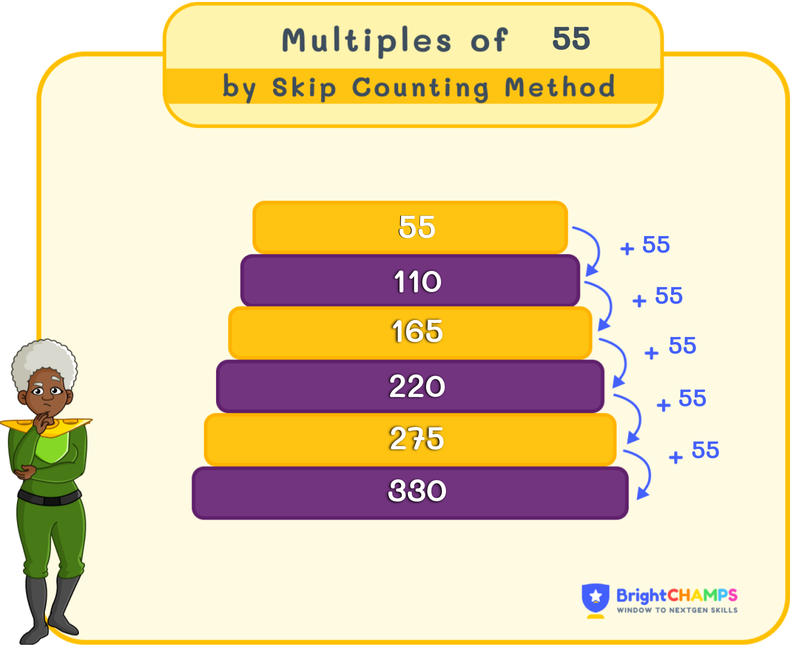
 151 Learners
151 LearnersLast updated on May 26th, 2025

Multiples of 55

In math, multiples are the products we get while multiplying a number with other numbers. Multiples play a key role in construction and design, counting groups of items, sharing resources equally, and managing time effectively. In this topic, we will learn the essential concepts of multiples of 55.
What are the Multiples of 55?
Now, let us learn more about multiples of 55. Multiples of 55 are the numbers you get when you multiply 55 by any whole number, along with zero. Each number has an infinite number of multiples, including a multiple of itself. In multiplication, a multiple of 55 can be denoted as 55 × n, where ‘n’ represents any whole number (0, 1, 2, 3,…). So, we can summarize that:
Multiple of a number = Number × Any whole number
For example, multiplying 55 × 1 will give us 55 as the product. Multiples of 55 will be larger or equal to 55.

Struggling with Math?
Get 1:1 Coaching to Boost Grades Fast !

List of First 20 Multiples of 55
Multiples of 55 include the products of 55 and an integer. Multiples of 55 are divisible by 55 evenly. The first few multiples of 55 are given below:
Now, we know the first few multiples of 55. They are 0, 55, 110, 165, 220, 275, 330, 385, 440, 495, 550,...
Operations with Multiples of 55
Understanding the multiples of 55 helps solve mathematical problems and boost our multiplication and division skills. When working with multiples of 55, we need to apply it to different mathematical operations such as addition, subtraction, multiplication, and division.
Sum of first 5 Multiples of 55:
55, 110, 165, 220, and 275 are the first five multiples of 55. When multiplying 55 from 1 to 5, we get these numbers as the products.
So, the sum of these multiples is:
55 + 110 + 165 + 220 + 275 = 825
When we add the first 5 multiples of 55, the answer will be 825.
Subtraction of first 5 Multiples of 55:
While we do subtraction, it improves our comprehension of how the value decreases when each multiple is subtracted from the previous one. 55, 110, 165, 220, and 275 are the first five multiples of 55. So, let us calculate it as given below:
55 - 110 = -55
-55 - 165 = -220
-220 - 220 = -440
-440 - 275 = -715
Hence, the result of subtracting the first 5 multiples of 55 is -715.
Average of first 5 Multiples of 55:
To calculate the average, we need to identify the sum of the first 5 multiples of 55, and then divide it by the count, i.e., 5. Because there are 5 multiples presented in the calculation. Averaging helps us to understand the concepts of central tendencies and other values. We know the sum of the first 5 multiples of 55 is 825.
55 + 110 + 165 + 220 + 275 = 825
Next, divide the sum by 5:
825 ÷ 5 = 165
165 is the average of the first 5 multiples of 55.
Product of First 5 Multiples of 55:
The product of given numbers is the result of multiplying all of them together. Here, the first 5 multiples of 55 include: 55, 110, 165, 220, and 275. Now, the product of these numbers is:
55 × 110 × 165 × 220 × 275 = 54,274,125,000
The product of the first 5 multiples of 55 is 54,274,125,000.
Division of First 5 Multiples of 55:
While we perform division, we get to know how many times 55 can fit into each of the given multiples. 55, 110, 165, 220, and 275 are the first 5 multiples of 55.
55 ÷ 55 = 1
110 ÷ 55 = 2
165 ÷ 55 = 3
220 ÷ 55 = 4
275 ÷ 55 = 5
The results of dividing the first 5 multiples of 55 are: 1, 2, 3, 4, and 5.

Common Mistakes and How to Avoid Them in Multiples of 55
While working with multiples of 55, we make common mistakes. Identifying these errors and understanding how to avoid them can be helpful. Below are some frequent mistakes and tips to avoid them:
Level Up with a Math Certification!
2X Faster Learning (Grades 1-12)


Multiples of 55 Examples

Problem 1
Maya is organizing a charity event where she plans to distribute gift bags. Each gift bag contains 55 items. If she manages to prepare gift bags every week for 5 weeks, how many items will she have distributed in total by the end of the event?

275 items
Explanation
Each week, Maya prepares gift bags with 55 items. To find the total number of items distributed after 5 weeks, multiply 55 by 5.
Items per week = 55
Number of weeks = 5
55 × 5 = 275
Maya will have distributed 275 items by the end of the event.

Problem 2
In a workshop, 55 participants are grouped according to the first three multiples of 55. How many participants are there in each group?

The first three multiples of 55 are 55, 110, and 165. The groups have 55, 110, and 165 participants respectively.
Explanation
The first three multiples of 55 are calculated as follows:
55 × 1 = 55
55 × 2 = 110
55 × 3 = 165
Hence, the groups have 55, 110, and 165 participants each.

Problem 3
A publishing company prints books in batches. Each batch contains 55 copies. If the company prints 8 batches, how many books do they print in total?

440 books
Explanation
To find the total number of books printed, multiply the number of batches by the number of copies in each batch.
Number of batches = 8
Copies per batch = 55
8 × 55 = 440
Therefore, the company prints a total of 440 books.

Problem 4
A textile factory produces rolls of fabric. Each roll contains 55 meters of fabric. If the factory produces 6 rolls, how many meters of fabric are produced in total?

330 meters
Explanation
To find the total meters of fabric produced, multiply the number of rolls by the meters in each roll.
Number of rolls = 6
Meters per roll = 55
6 × 55 = 330
So, the factory produces 330 meters of fabric in total.

Problem 5
A school is organizing a fundraising run, where each lap completed by a student raises 55 dollars. If a student completes 3 laps, another completes 5 laps, and a third completes 7 laps, how much money is raised in total?

825 dollars
Explanation
Calculate the money raised by each student and sum them up.
First student: 55 × 3 = 165 dollars
Second student: 55 × 5 = 275 dollars
Third student: 55 × 7 = 385 dollars
Total money raised: 165 + 275 + 385 = 825 dollars
Therefore, the total money raised is 825 dollars.

Turn your child into a math star!
#1 Math Hack Schools Won't Teach!


FAQs on Multiples of 55
1.How do you find the multiples of 55?
2.What is the LCM of 11 and 55?
3.What are the real-life applications of Multiples of 55?
4.Are multiples of 55 finite or infinite?
5.Is there any odd multiples of 55?
6.How can poems help children in Singapore memorize the Multiplication Table and Multiples of 55?
7.Can learning the Multiplication Table influence creativity in solving Multiples of 55 challenges for kids in Singapore?
8.How do language and cultural differences in Singapore affect the way children learn the Multiplication Table and Multiples of 55?
9.What role does brain development play in mastering the Multiplication Table and Multiples of 55 among early learners in Singapore?
Struggling with Math?
Get 1:1 Coaching to Boost Grades Fast !

Important Glossaries for Multiples of 55
- Multiple: A multiple represents the product of a number that may be multiplied by an integer. For example, multiples of 55 include 55, 110, 165, 220, etc.
- Number pattern: This refers to how numbers are listed. It should follow a certain sequence. Multiples of 55 are the numbers that consist of the number pattern of 55.
- Odd number: An odd number is any number that cannot be evenly divided by 2. Multiples of 55 can be odd when the multiplier is an odd number.
- Divisor: It refers to any number by which another number can be divided without leaving any remainder. 1, 5, 11, and 55 are the divisors of 55.
- Least Common Multiple (LCM): The smallest number that is a multiple of two or more numbers. For example, the LCM of 11 and 55 is 55.
Explore More multiplication-tables
![Important Math Links Icon]() Previous to Multiples of 55
Previous to Multiples of 55
About BrightChamps in Singapore


Seyed Ali Fathima S
About the Author
Seyed Ali Fathima S a math expert with nearly 5 years of experience as a math teacher. From an engineer to a math teacher, shows her passion for math and teaching. She is a calculator queen, who loves tables and she turns tables to puzzles and songs.
Fun Fact
: She has songs for each table which helps her to remember the tables




